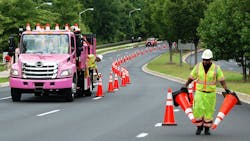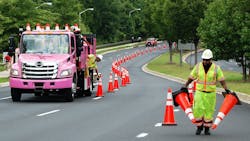Contractors can pave the way to safer work zones across the U.S.
America’s vast highway system endures a significant amount of wear and tear annually with over 3.1 trillion vehicle miles of travel each year. That number continues to climb with the rapid growth of e-commerce directly impacting the volume of trucks on our roadways. In fact, Texas A&M University Transportation Institute estimates that trucks are responsible for 28% of roadway congestion despite only taking up 7% of traffic.
As roads degrade and require repair or expansion to accommodate the influx of traffic, work zones remain the lifeline through which this critical maintenance is possible. However, while work zones are vital to our transportation network, they are also progressively becoming more dangerous. Increased speed limits, distracted drivers, and even self-driving vehicles have created the perfect conditions for inevitable collisions in and around work zones.
Just how dangerous are they? In 2017, there were 799 fatalities in work zones throughout the U.S., representing a 10-year high. Approximately 16.5% of these fatalities involved workers in a zone. From 2016 to 2017, fatal crashes inside work zones increased by 3% while fatal crashes outside work zones decreased by 1.5%. Work zone intrusions and impacts have become so commonplace that it is no longer an ‘if’ scenario but rather a ‘when’ situation in which the outcome is directly affected by the safety of the work zone itself. This is where there is a disconnect.
The definition of a ‘safe work zone’ is not one that is universal. In fact, every state in the U.S. plays by its own rules. States such as Texas, New Jersey, and California are among the strictest with regards to work zone regulations while states like Ohio, Nevada, and Georgia have minimal to no regulations at all. Why is this important? In states without regulations, contractors are entrusted with determining what makes a work zone safe, and it is assumed that they are both diligent and knowledgeable in their approach to work zone safety. With no overruling authority providing guidelines as to what constitutes a ‘safe work zone’ or enforcing standards with regards to the equipment itself, it is left open to interpretation by the contractor. There are several problems with this approach.
The first, and most obvious problem, is cost. Construction contractors may opt to reduce costs in several ways including minimally investing in proper training for its workers, using equipment which is not built to the highest safety standards, or sacrificing necessary life-saving equipment such as TMA trucks that act as barriers between the workers in the zone and the traveling public and backup cameras. In fact, ARTBA lists being run over or backed over by vehicles as the leading cause of fatalities for workers in work zones.
Another problem stemming from the absence of state-regulated work zone safety guidelines is that contractors may simply lack the knowledge of how to properly set up a work zone. This may include awareness of minimum standards for safety equipment or the required roll-ahead distance needed for stationary and moving operations. Regardless of whether the problem involves cost-savings or general lack of knowledge, both scenarios could result in a work zone death which may otherwise have been avoided.
The good news is that as states gradually become more regulated in making work zones safer, new advances in technology are already available now which can be leveraged by contractors who are willing to make the investment. These technological advances present a much needed positive shift towards both prevention and protection in the work zone. Recent trends include high-visibility reflective apparel, DVR and backup cameras, connected arrow boards that transmit alerts via Waze to traveling motorists, VR programs that can be used to train and test workers before setting foot in a work zone, and even autonomous TMA trucks that eliminate the need for a driver. Contractors who are committed to prioritizing safety over cost will ultimately benefit in the long run with reducing liability claims resulting from an accident with the equipment, avoiding impact events involving the traveling public, and, most importantly, having the ability to ensure every worker is able to go home to his or her family at the end of each shift.

